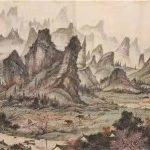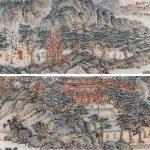Interview with Glenn Parsons
Issue 4 – By; Zuha Rasheed
Glenn Parsons is a philosopher and associate Professor at Ryerson University in Toronto. His interests include aesthetics, metaphysics and philosophy of science. His current research is in philosophical aesthetics, mainly focusing on the aesthetics of nature, design and human beings.
He is the author of various articles and books such us Functional Beauty, The Philosophy of Design, Aesthetics and Nature.

Z.R.
The world in which we live in, through the instantaneousness of the exchange of information, the ease of diffusion of goods and movements in general, has led to the illusion that a Wikipedia page is enough to possess any type of knowledge. Therefore, the maximum that can be achieved is a collection of a whole series of information, which in most cases, does not have any cultural substrate on which to rely on. This is especially true when dealing with other cultures which are often considered inferior to the western ones or read in a westernizing key, distorting their meanings. We do not take other cultures into consideration or believe that they have created systems of thoughts different from the western one, even though they are equally complex, such as the Chinese for instance, where a founding idea that was the basis of all thought, is the one that sees the world in a holistic key. A concept that is at the basis of the environmental aesthetics that from Yijing reaches Confucian and Daoist thoughts, and finds its main expression in the concept of balance and harmony. So could this be useful to solve the problems that afflict contemporaneity, including those related to the environment?
G.P.
That is a question that I doubt we can answer a priori: environmental problems are complex and varied, and it is probably the case that no one ‘philosophical worldview’ holds all the solutions. To my mind, what matters is not very high-level, abstract conceptions of the human-nature relation, but the practical ways in which different approaches manage environmental problems. That said, I think every culture can learn from the experiences of others. The Chinese intellectual tradition is unusually rich and no doubt there is much that Westerners can learn from it.
Z.R.
This holistic vision, born in the pre-imperial period, was subsequently integrated into the theory of the kind of paintings that has the natural environment as its main subject, and is commonly called Chinese landscape painting (shanshui hua or mountain and water painting) in the West, which sees the final work not as a visual representation of the environment, but as an expression of the artist’s inner reality through natural inspiration. This type of emotional and intimate approach naturally requires a relationship of extreme closeness and knowledge towards nature on the part of the artist. Could this vision not somehow replace that of Scientific cognitivism? That is to appreciate nature not through scientific knowledge but rather an emotional and intimate knowledge?
G.P.
Obviously, there are many differences between the traditions of landscape painting in China and in the West. But the idea of seeing landscape in terms of the artist’s inner reality and human emotion felt in response to nature has not been totally alien to the West. It is certainly prominent in Romanticism, and to an extent was perhaps present also in the earlier traditions of pastoral and Georgic landscape painting.
As for whether this approach could replace ‘scientific cognitivism’, I don’t think it is a simple matter of choosing one or the other. Approaching nature with naturalistic understanding doesn’t preclude responding to nature emotionally, nor does it rule out an intimate relationship to natural things. There is also a place for relating to nature in a purely personal way, as when we project our own moods or experiences onto nature. This has, obviously, long been fertile territory for artists. But we needn’t conclude that this is the only, or the most appropriate way, to relate to natural beauty.
Z.R.
Isn’t it precisely the modern scientific approach that considers nature as an object, as an instrument, as a field to be enslaved and exploited, that which takes man further and further away from nature?
G.P.
The ‘modern scientific approach’ is more complex than that; this description would be a caricature at best. Contemporary biology views our species as one among many: we share a common evolutionary past and a common natural environment with all other living things. So, in that sense, science could be said to have brought us much closer to nature, rather than distanced us from it. But once again, I would suggest that what matters in terms of solving environmental problems is not so much these very abstract metaphysical views, but a range of more practical, local considerations. Blaming one philosophical view for our environmental ills—whether that view comes from science, or religion, or whatever—is probably a naive analysis.
Z.R.
We see how basically in western view, man and nature are two separate elements, indeed the landscape arises precisely when this division becomes more marked, so much so that the environmental aesthetics has put aside the term landscape. Unlike in China, where mountain and water painting continues to be one of the main artistic expressions, but in this pictorial form nature is not represented as seen by the subject, but rather the painter will try to represent nature in its essence, because he does not have a position of superiority towards it, nor does he have any interest in representing his material point of view, thus cancelling the subject. Could the almost total disappearance of landscape painting in the western artistic sphere be linked to this phenomenon?
G.P.
The term ‘landscape’ hasn’t disappeared completely in environmental aesthetics, though many philosophers would find problems with it. As for what explains the decline of landscape painting in Western art, that is a big question for Art history. Landscape painting was never a major genre in European painting, except perhaps for a short period in the late nineteenth century. In the early twentieth century it was eclipsed, to be sure, but so were many traditional genres (the portrait, historical painting, etc). I’m not sure that this development in Western art had much to do with issues concerning the human-nature relationship. On the other hand, new forms of art did arise in the twentieth century that were, in various ways, prompted by reflection on the human-nature relationship (land art, for example).
Z.R.
Environmental aesthetics has put art aside a little, since the aesthetic experience of nature wants to be lived in nature, but unfortunately, for a whole series of reasons, this type of experience is not for everyone. This also applies to environmental problems, which despite being a common conscience, people rarely experience it directly, especially as regards to specific problems in different areas of the planet. In your opinion, in the contemporary world, can art recover an important role in putting man and nature in contact?
G.P.
Yes, I think so. Some philosophers worried that art (in particular landscape painting) provided a poor model for how we should appreciate the natural world. The worry was that we would treat nature like a gallery of paintings, admiring only the most ‘well composed views’, etc. This was a valid worry because something like this did take hold of the public imagination in 18th century England, during the heyday of the ‘Picturesque’. But, as some philosophers have pointed out, art in general can help, as well as hinder, our appreciation of nature.
Z.R.
Western painting in recent decades has hardly kept pace with other forms of artistic expressions. Could a change of approach towards the world, thus embracing the holistic conception of the existence of the Chinese view, give new food for thought and open new avenues for creativity and more sensitivity towards environmental problems in general?
G.P.
I’m not an art critic or historian, so I can’t speak to this claim about Western painting having fallen behind. In general, openness to ideas and influences from different cultures seems like a good thing for Art. But that said, I don’t think that it is so easy for one culture to simply ‘embrace’ the conceptions and philosophies of other cultures. Chinese holism, for instance, is grounded in thousands of years of unique experience and is manifested in innumerable social contexts and practices that are particular to Chinese society. Artists in different societies have to process these influences in their own ways, with unpredictable results. But as I said, mutual exchange of ideas and influences across cultures seems like something we should certainly try to foster, in Art as in other areas as well.
Read the full magazine






